BUSN2024 Report: Sustainable Resource Management at Daimler AG
VerifiedAdded on 2022/09/13
|14
|3441
|10
Report
AI Summary
This report provides a comprehensive analysis of Daimler AG's sustainable resource management practices. It begins with an overview of the company, its background, and its core values, followed by an in-depth examination of its stakeholders, including marginalized, overlooked, and underestimated groups. The report then applies the Triple Bottom Line framework (Profit, People, Planet) to assess Daimler AG's performance across economic, social, and environmental dimensions, supported by financial data and initiatives. The GRI index is used to evaluate the extent of sustainability concerning social and environmental issues. A SWOT analysis is conducted, and a TOWS matrix is developed to identify strategic options. Finally, the report offers recommendations based on the findings and concludes with an assessment of Daimler AG's overall approach to sustainable resource management. The report highlights Daimler AG's commitment to sustainability through various initiatives and its efforts to balance financial success with social and environmental responsibility.
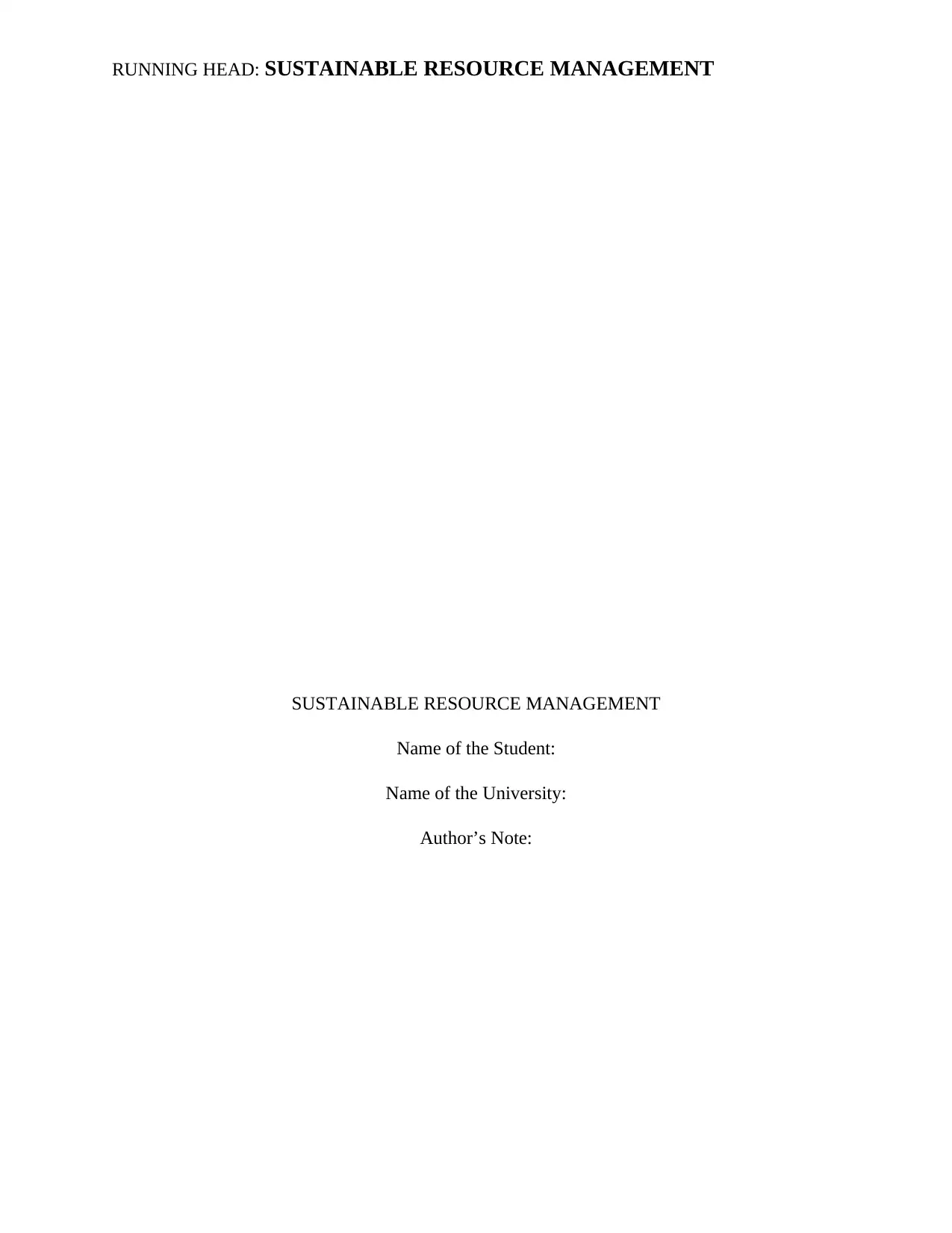
RUNNING HEAD: SUSTAINABLE RESOURCE MANAGEMENT
SUSTAINABLE RESOURCE MANAGEMENT
Name of the Student:
Name of the University:
Author’s Note:
SUSTAINABLE RESOURCE MANAGEMENT
Name of the Student:
Name of the University:
Author’s Note:
Paraphrase This Document
Need a fresh take? Get an instant paraphrase of this document with our AI Paraphraser
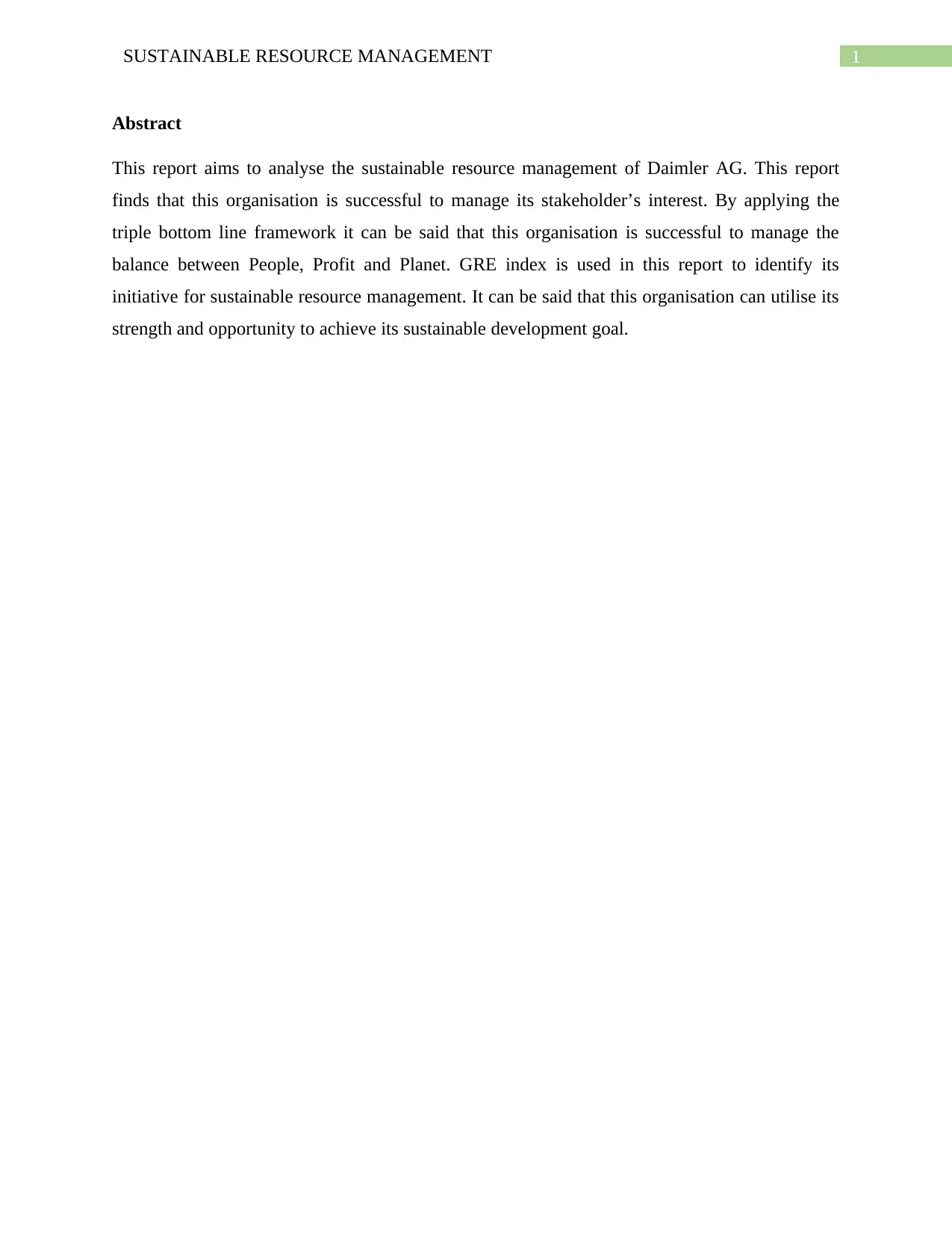
1SUSTAINABLE RESOURCE MANAGEMENT
Abstract
This report aims to analyse the sustainable resource management of Daimler AG. This report
finds that this organisation is successful to manage its stakeholder’s interest. By applying the
triple bottom line framework it can be said that this organisation is successful to manage the
balance between People, Profit and Planet. GRE index is used in this report to identify its
initiative for sustainable resource management. It can be said that this organisation can utilise its
strength and opportunity to achieve its sustainable development goal.
Abstract
This report aims to analyse the sustainable resource management of Daimler AG. This report
finds that this organisation is successful to manage its stakeholder’s interest. By applying the
triple bottom line framework it can be said that this organisation is successful to manage the
balance between People, Profit and Planet. GRE index is used in this report to identify its
initiative for sustainable resource management. It can be said that this organisation can utilise its
strength and opportunity to achieve its sustainable development goal.
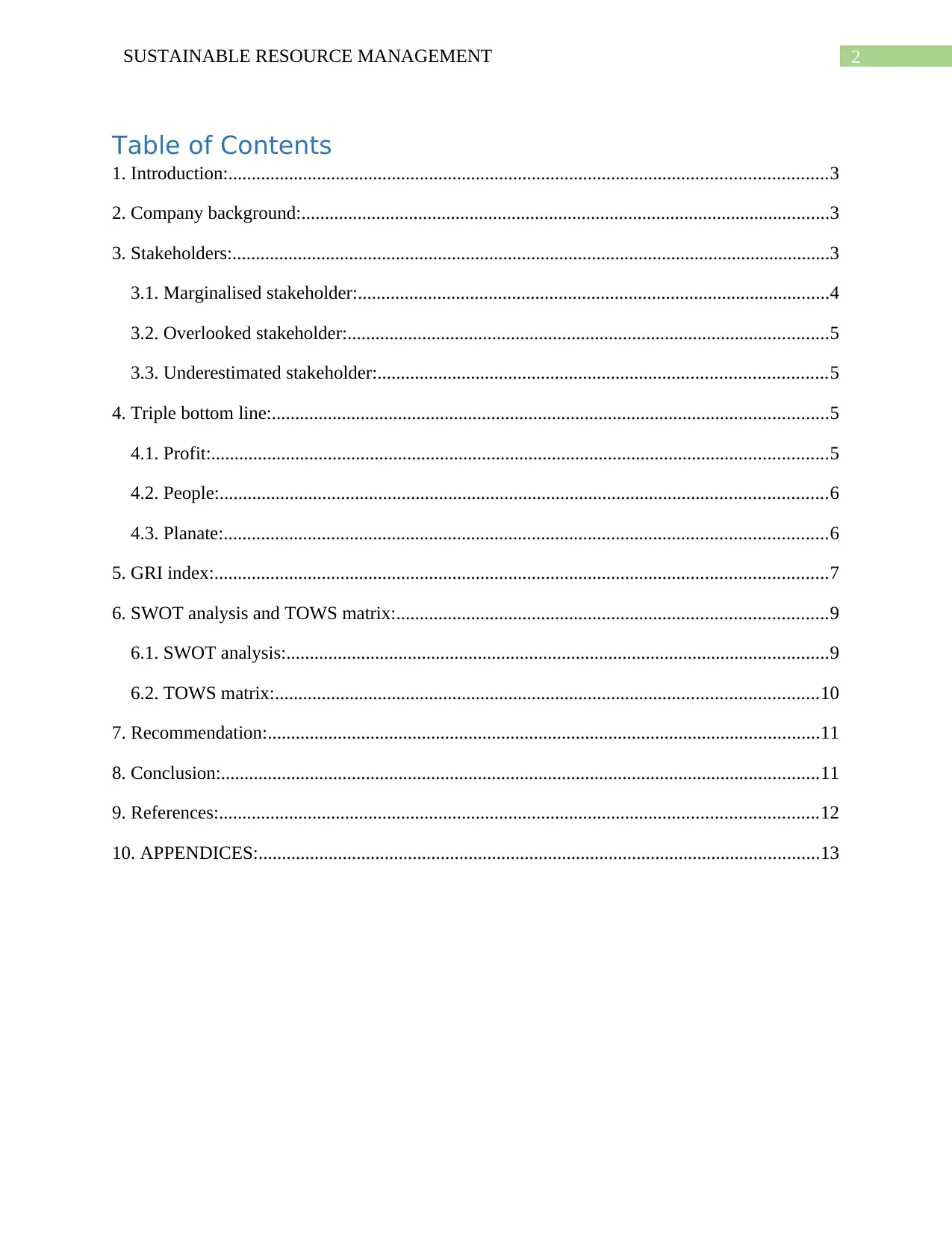
2SUSTAINABLE RESOURCE MANAGEMENT
Table of Contents
1. Introduction:................................................................................................................................3
2. Company background:.................................................................................................................3
3. Stakeholders:................................................................................................................................3
3.1. Marginalised stakeholder:.....................................................................................................4
3.2. Overlooked stakeholder:.......................................................................................................5
3.3. Underestimated stakeholder:................................................................................................5
4. Triple bottom line:.......................................................................................................................5
4.1. Profit:....................................................................................................................................5
4.2. People:..................................................................................................................................6
4.3. Planate:.................................................................................................................................6
5. GRI index:...................................................................................................................................7
6. SWOT analysis and TOWS matrix:............................................................................................9
6.1. SWOT analysis:....................................................................................................................9
6.2. TOWS matrix:....................................................................................................................10
7. Recommendation:......................................................................................................................11
8. Conclusion:................................................................................................................................11
9. References:................................................................................................................................12
10. APPENDICES:........................................................................................................................13
Table of Contents
1. Introduction:................................................................................................................................3
2. Company background:.................................................................................................................3
3. Stakeholders:................................................................................................................................3
3.1. Marginalised stakeholder:.....................................................................................................4
3.2. Overlooked stakeholder:.......................................................................................................5
3.3. Underestimated stakeholder:................................................................................................5
4. Triple bottom line:.......................................................................................................................5
4.1. Profit:....................................................................................................................................5
4.2. People:..................................................................................................................................6
4.3. Planate:.................................................................................................................................6
5. GRI index:...................................................................................................................................7
6. SWOT analysis and TOWS matrix:............................................................................................9
6.1. SWOT analysis:....................................................................................................................9
6.2. TOWS matrix:....................................................................................................................10
7. Recommendation:......................................................................................................................11
8. Conclusion:................................................................................................................................11
9. References:................................................................................................................................12
10. APPENDICES:........................................................................................................................13
⊘ This is a preview!⊘
Do you want full access?
Subscribe today to unlock all pages.

Trusted by 1+ million students worldwide
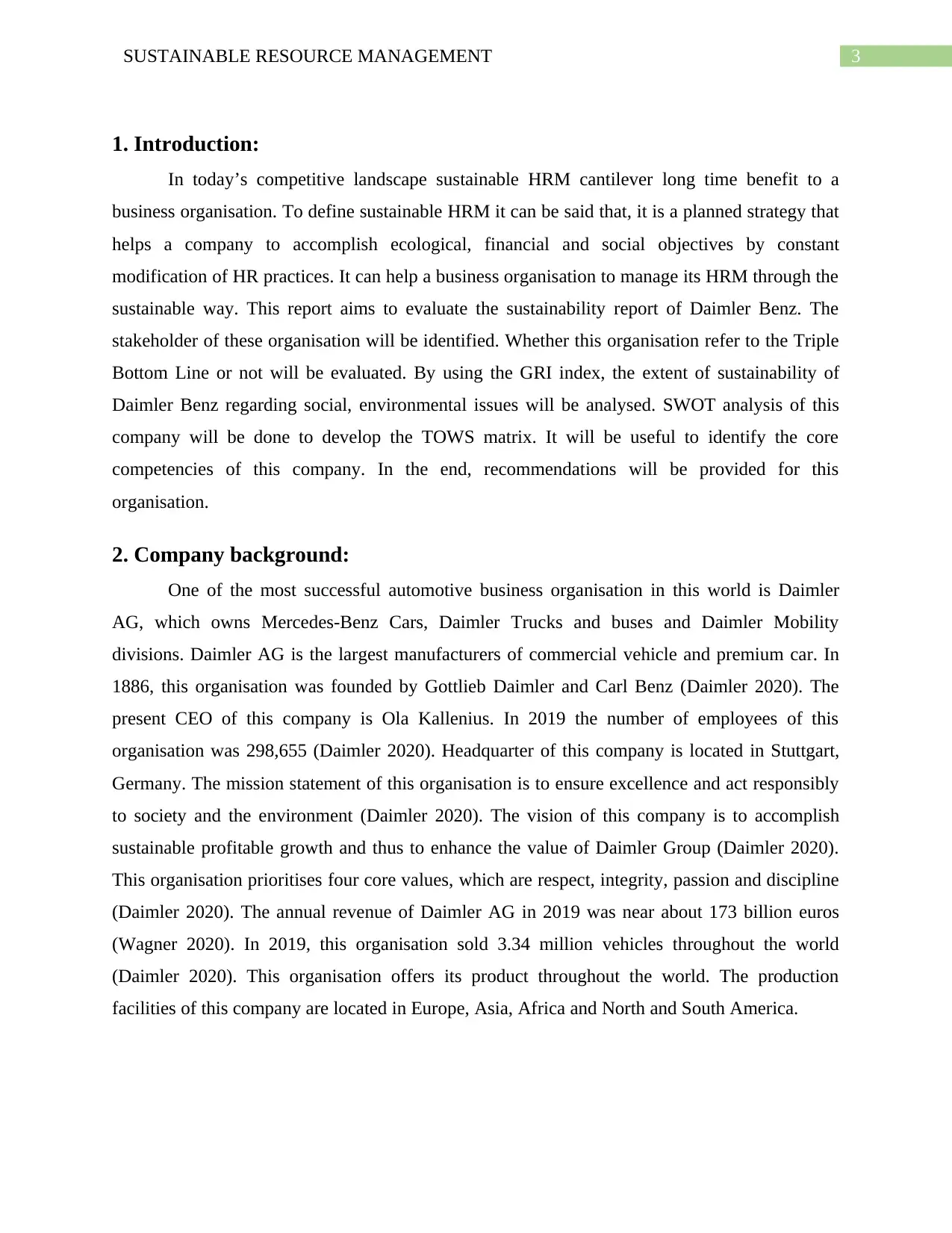
3SUSTAINABLE RESOURCE MANAGEMENT
1. Introduction:
In today’s competitive landscape sustainable HRM cantilever long time benefit to a
business organisation. To define sustainable HRM it can be said that, it is a planned strategy that
helps a company to accomplish ecological, financial and social objectives by constant
modification of HR practices. It can help a business organisation to manage its HRM through the
sustainable way. This report aims to evaluate the sustainability report of Daimler Benz. The
stakeholder of these organisation will be identified. Whether this organisation refer to the Triple
Bottom Line or not will be evaluated. By using the GRI index, the extent of sustainability of
Daimler Benz regarding social, environmental issues will be analysed. SWOT analysis of this
company will be done to develop the TOWS matrix. It will be useful to identify the core
competencies of this company. In the end, recommendations will be provided for this
organisation.
2. Company background:
One of the most successful automotive business organisation in this world is Daimler
AG, which owns Mercedes-Benz Cars, Daimler Trucks and buses and Daimler Mobility
divisions. Daimler AG is the largest manufacturers of commercial vehicle and premium car. In
1886, this organisation was founded by Gottlieb Daimler and Carl Benz (Daimler 2020). The
present CEO of this company is Ola Kallenius. In 2019 the number of employees of this
organisation was 298,655 (Daimler 2020). Headquarter of this company is located in Stuttgart,
Germany. The mission statement of this organisation is to ensure excellence and act responsibly
to society and the environment (Daimler 2020). The vision of this company is to accomplish
sustainable profitable growth and thus to enhance the value of Daimler Group (Daimler 2020).
This organisation prioritises four core values, which are respect, integrity, passion and discipline
(Daimler 2020). The annual revenue of Daimler AG in 2019 was near about 173 billion euros
(Wagner 2020). In 2019, this organisation sold 3.34 million vehicles throughout the world
(Daimler 2020). This organisation offers its product throughout the world. The production
facilities of this company are located in Europe, Asia, Africa and North and South America.
1. Introduction:
In today’s competitive landscape sustainable HRM cantilever long time benefit to a
business organisation. To define sustainable HRM it can be said that, it is a planned strategy that
helps a company to accomplish ecological, financial and social objectives by constant
modification of HR practices. It can help a business organisation to manage its HRM through the
sustainable way. This report aims to evaluate the sustainability report of Daimler Benz. The
stakeholder of these organisation will be identified. Whether this organisation refer to the Triple
Bottom Line or not will be evaluated. By using the GRI index, the extent of sustainability of
Daimler Benz regarding social, environmental issues will be analysed. SWOT analysis of this
company will be done to develop the TOWS matrix. It will be useful to identify the core
competencies of this company. In the end, recommendations will be provided for this
organisation.
2. Company background:
One of the most successful automotive business organisation in this world is Daimler
AG, which owns Mercedes-Benz Cars, Daimler Trucks and buses and Daimler Mobility
divisions. Daimler AG is the largest manufacturers of commercial vehicle and premium car. In
1886, this organisation was founded by Gottlieb Daimler and Carl Benz (Daimler 2020). The
present CEO of this company is Ola Kallenius. In 2019 the number of employees of this
organisation was 298,655 (Daimler 2020). Headquarter of this company is located in Stuttgart,
Germany. The mission statement of this organisation is to ensure excellence and act responsibly
to society and the environment (Daimler 2020). The vision of this company is to accomplish
sustainable profitable growth and thus to enhance the value of Daimler Group (Daimler 2020).
This organisation prioritises four core values, which are respect, integrity, passion and discipline
(Daimler 2020). The annual revenue of Daimler AG in 2019 was near about 173 billion euros
(Wagner 2020). In 2019, this organisation sold 3.34 million vehicles throughout the world
(Daimler 2020). This organisation offers its product throughout the world. The production
facilities of this company are located in Europe, Asia, Africa and North and South America.
Paraphrase This Document
Need a fresh take? Get an instant paraphrase of this document with our AI Paraphraser
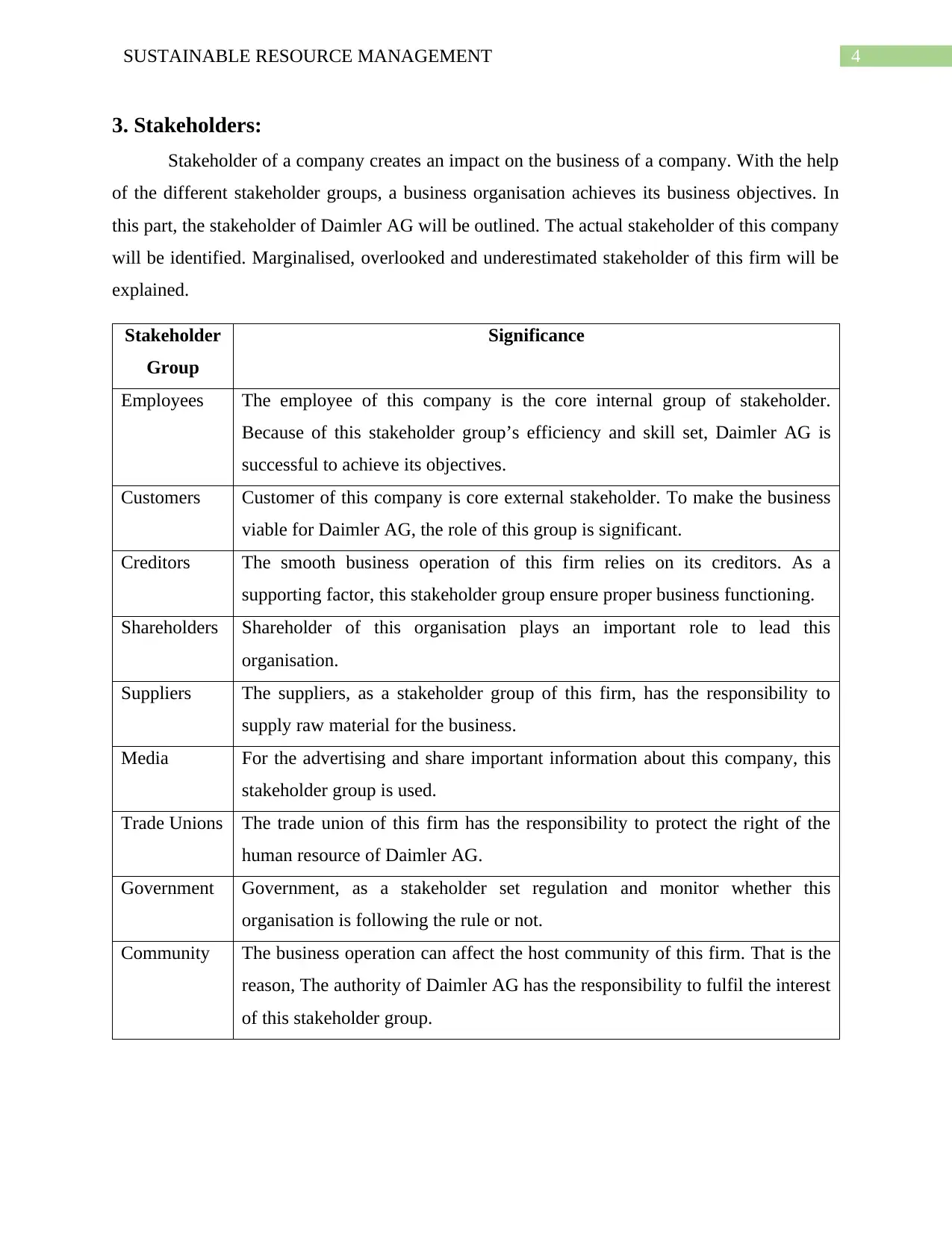
4SUSTAINABLE RESOURCE MANAGEMENT
3. Stakeholders:
Stakeholder of a company creates an impact on the business of a company. With the help
of the different stakeholder groups, a business organisation achieves its business objectives. In
this part, the stakeholder of Daimler AG will be outlined. The actual stakeholder of this company
will be identified. Marginalised, overlooked and underestimated stakeholder of this firm will be
explained.
Stakeholder
Group
Significance
Employees The employee of this company is the core internal group of stakeholder.
Because of this stakeholder group’s efficiency and skill set, Daimler AG is
successful to achieve its objectives.
Customers Customer of this company is core external stakeholder. To make the business
viable for Daimler AG, the role of this group is significant.
Creditors The smooth business operation of this firm relies on its creditors. As a
supporting factor, this stakeholder group ensure proper business functioning.
Shareholders Shareholder of this organisation plays an important role to lead this
organisation.
Suppliers The suppliers, as a stakeholder group of this firm, has the responsibility to
supply raw material for the business.
Media For the advertising and share important information about this company, this
stakeholder group is used.
Trade Unions The trade union of this firm has the responsibility to protect the right of the
human resource of Daimler AG.
Government Government, as a stakeholder set regulation and monitor whether this
organisation is following the rule or not.
Community The business operation can affect the host community of this firm. That is the
reason, The authority of Daimler AG has the responsibility to fulfil the interest
of this stakeholder group.
3. Stakeholders:
Stakeholder of a company creates an impact on the business of a company. With the help
of the different stakeholder groups, a business organisation achieves its business objectives. In
this part, the stakeholder of Daimler AG will be outlined. The actual stakeholder of this company
will be identified. Marginalised, overlooked and underestimated stakeholder of this firm will be
explained.
Stakeholder
Group
Significance
Employees The employee of this company is the core internal group of stakeholder.
Because of this stakeholder group’s efficiency and skill set, Daimler AG is
successful to achieve its objectives.
Customers Customer of this company is core external stakeholder. To make the business
viable for Daimler AG, the role of this group is significant.
Creditors The smooth business operation of this firm relies on its creditors. As a
supporting factor, this stakeholder group ensure proper business functioning.
Shareholders Shareholder of this organisation plays an important role to lead this
organisation.
Suppliers The suppliers, as a stakeholder group of this firm, has the responsibility to
supply raw material for the business.
Media For the advertising and share important information about this company, this
stakeholder group is used.
Trade Unions The trade union of this firm has the responsibility to protect the right of the
human resource of Daimler AG.
Government Government, as a stakeholder set regulation and monitor whether this
organisation is following the rule or not.
Community The business operation can affect the host community of this firm. That is the
reason, The authority of Daimler AG has the responsibility to fulfil the interest
of this stakeholder group.
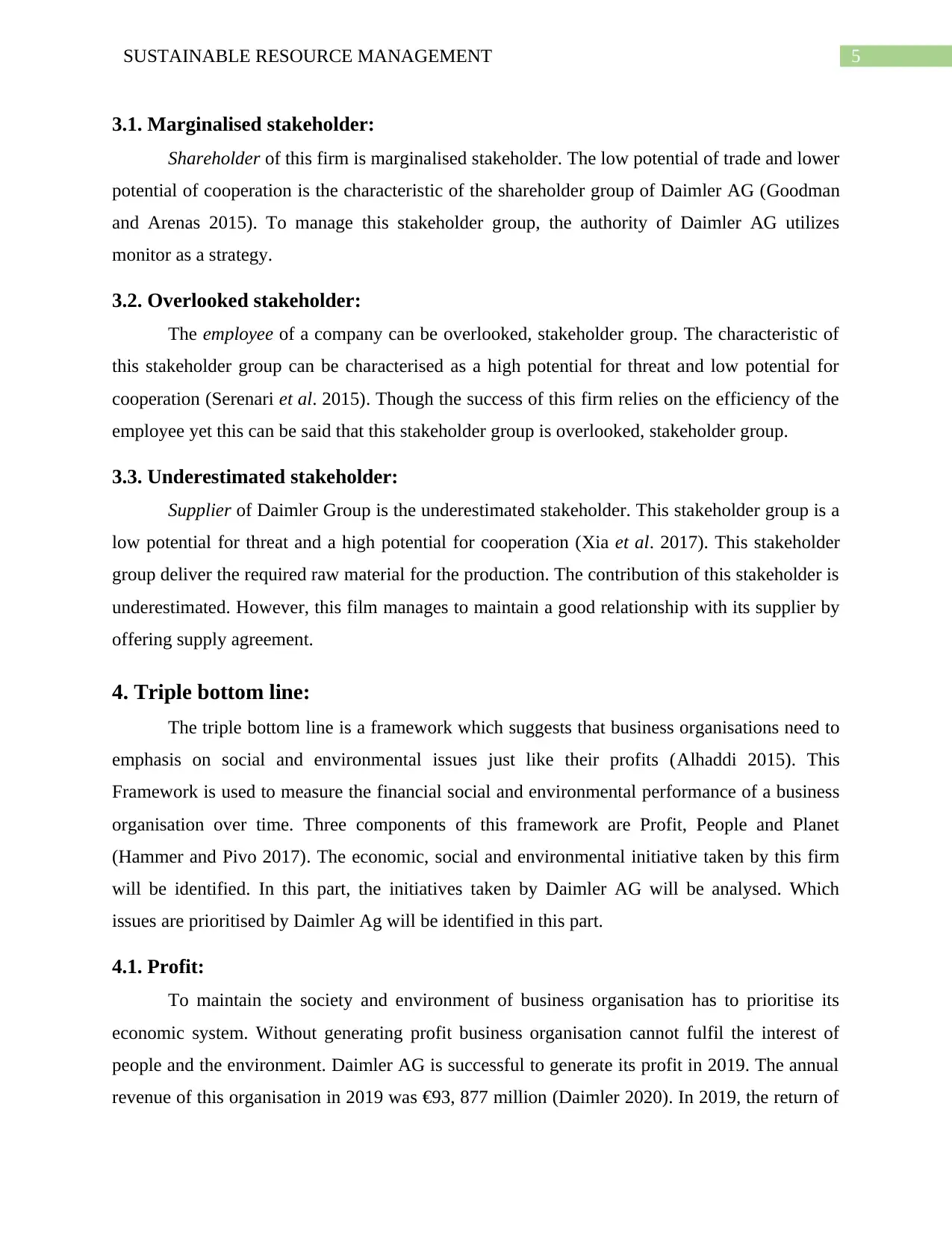
5SUSTAINABLE RESOURCE MANAGEMENT
3.1. Marginalised stakeholder:
Shareholder of this firm is marginalised stakeholder. The low potential of trade and lower
potential of cooperation is the characteristic of the shareholder group of Daimler AG (Goodman
and Arenas 2015). To manage this stakeholder group, the authority of Daimler AG utilizes
monitor as a strategy.
3.2. Overlooked stakeholder:
The employee of a company can be overlooked, stakeholder group. The characteristic of
this stakeholder group can be characterised as a high potential for threat and low potential for
cooperation (Serenari et al. 2015). Though the success of this firm relies on the efficiency of the
employee yet this can be said that this stakeholder group is overlooked, stakeholder group.
3.3. Underestimated stakeholder:
Supplier of Daimler Group is the underestimated stakeholder. This stakeholder group is a
low potential for threat and a high potential for cooperation (Xia et al. 2017). This stakeholder
group deliver the required raw material for the production. The contribution of this stakeholder is
underestimated. However, this film manages to maintain a good relationship with its supplier by
offering supply agreement.
4. Triple bottom line:
The triple bottom line is a framework which suggests that business organisations need to
emphasis on social and environmental issues just like their profits (Alhaddi 2015). This
Framework is used to measure the financial social and environmental performance of a business
organisation over time. Three components of this framework are Profit, People and Planet
(Hammer and Pivo 2017). The economic, social and environmental initiative taken by this firm
will be identified. In this part, the initiatives taken by Daimler AG will be analysed. Which
issues are prioritised by Daimler Ag will be identified in this part.
4.1. Profit:
To maintain the society and environment of business organisation has to prioritise its
economic system. Without generating profit business organisation cannot fulfil the interest of
people and the environment. Daimler AG is successful to generate its profit in 2019. The annual
revenue of this organisation in 2019 was €93, 877 million (Daimler 2020). In 2019, the return of
3.1. Marginalised stakeholder:
Shareholder of this firm is marginalised stakeholder. The low potential of trade and lower
potential of cooperation is the characteristic of the shareholder group of Daimler AG (Goodman
and Arenas 2015). To manage this stakeholder group, the authority of Daimler AG utilizes
monitor as a strategy.
3.2. Overlooked stakeholder:
The employee of a company can be overlooked, stakeholder group. The characteristic of
this stakeholder group can be characterised as a high potential for threat and low potential for
cooperation (Serenari et al. 2015). Though the success of this firm relies on the efficiency of the
employee yet this can be said that this stakeholder group is overlooked, stakeholder group.
3.3. Underestimated stakeholder:
Supplier of Daimler Group is the underestimated stakeholder. This stakeholder group is a
low potential for threat and a high potential for cooperation (Xia et al. 2017). This stakeholder
group deliver the required raw material for the production. The contribution of this stakeholder is
underestimated. However, this film manages to maintain a good relationship with its supplier by
offering supply agreement.
4. Triple bottom line:
The triple bottom line is a framework which suggests that business organisations need to
emphasis on social and environmental issues just like their profits (Alhaddi 2015). This
Framework is used to measure the financial social and environmental performance of a business
organisation over time. Three components of this framework are Profit, People and Planet
(Hammer and Pivo 2017). The economic, social and environmental initiative taken by this firm
will be identified. In this part, the initiatives taken by Daimler AG will be analysed. Which
issues are prioritised by Daimler Ag will be identified in this part.
4.1. Profit:
To maintain the society and environment of business organisation has to prioritise its
economic system. Without generating profit business organisation cannot fulfil the interest of
people and the environment. Daimler AG is successful to generate its profit in 2019. The annual
revenue of this organisation in 2019 was €93, 877 million (Daimler 2020). In 2019, the return of
⊘ This is a preview!⊘
Do you want full access?
Subscribe today to unlock all pages.

Trusted by 1+ million students worldwide
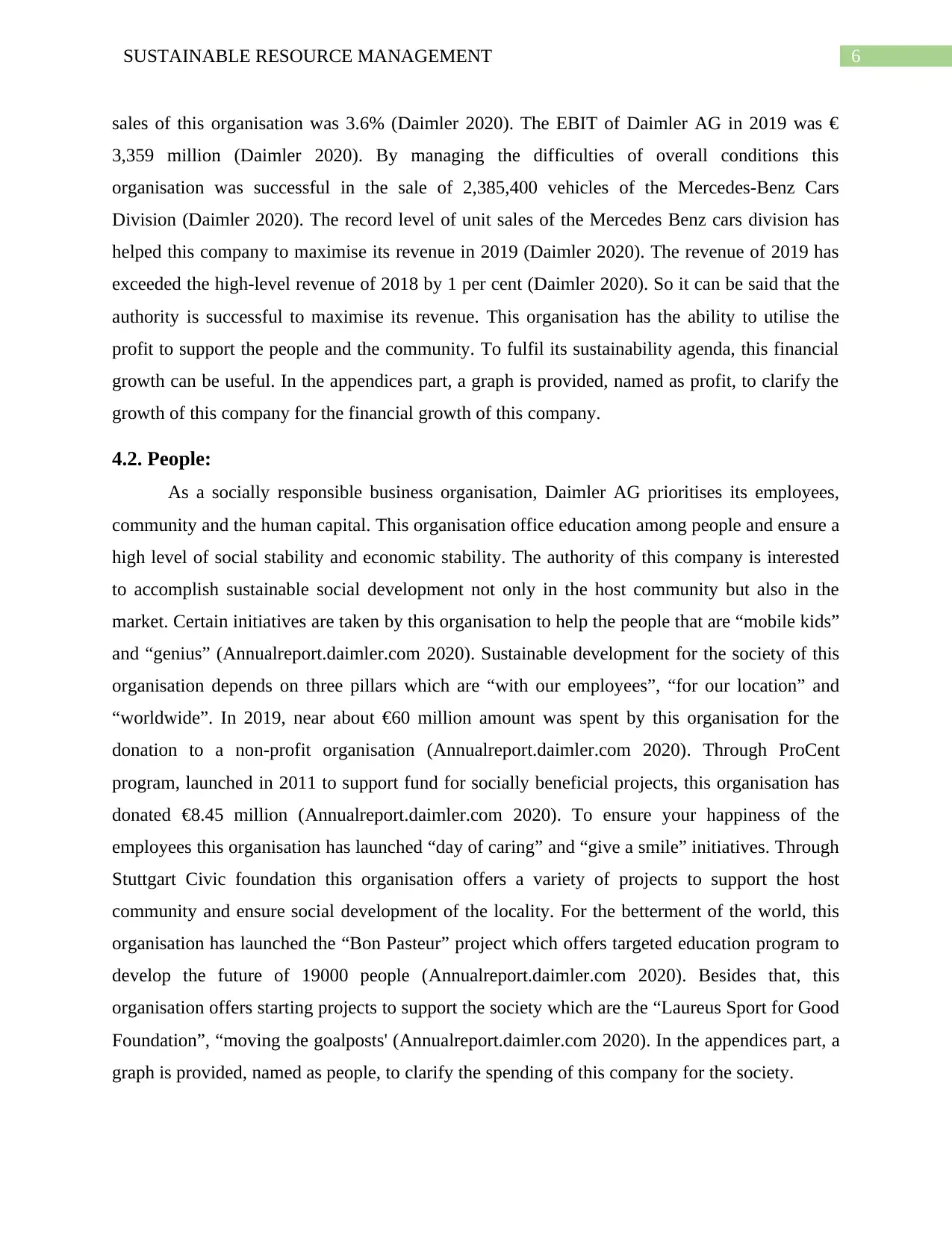
6SUSTAINABLE RESOURCE MANAGEMENT
sales of this organisation was 3.6% (Daimler 2020). The EBIT of Daimler AG in 2019 was €
3,359 million (Daimler 2020). By managing the difficulties of overall conditions this
organisation was successful in the sale of 2,385,400 vehicles of the Mercedes-Benz Cars
Division (Daimler 2020). The record level of unit sales of the Mercedes Benz cars division has
helped this company to maximise its revenue in 2019 (Daimler 2020). The revenue of 2019 has
exceeded the high-level revenue of 2018 by 1 per cent (Daimler 2020). So it can be said that the
authority is successful to maximise its revenue. This organisation has the ability to utilise the
profit to support the people and the community. To fulfil its sustainability agenda, this financial
growth can be useful. In the appendices part, a graph is provided, named as profit, to clarify the
growth of this company for the financial growth of this company.
4.2. People:
As a socially responsible business organisation, Daimler AG prioritises its employees,
community and the human capital. This organisation office education among people and ensure a
high level of social stability and economic stability. The authority of this company is interested
to accomplish sustainable social development not only in the host community but also in the
market. Certain initiatives are taken by this organisation to help the people that are “mobile kids”
and “genius” (Annualreport.daimler.com 2020). Sustainable development for the society of this
organisation depends on three pillars which are “with our employees”, “for our location” and
“worldwide”. In 2019, near about €60 million amount was spent by this organisation for the
donation to a non-profit organisation (Annualreport.daimler.com 2020). Through ProCent
program, launched in 2011 to support fund for socially beneficial projects, this organisation has
donated €8.45 million (Annualreport.daimler.com 2020). To ensure your happiness of the
employees this organisation has launched “day of caring” and “give a smile” initiatives. Through
Stuttgart Civic foundation this organisation offers a variety of projects to support the host
community and ensure social development of the locality. For the betterment of the world, this
organisation has launched the “Bon Pasteur” project which offers targeted education program to
develop the future of 19000 people (Annualreport.daimler.com 2020). Besides that, this
organisation offers starting projects to support the society which are the “Laureus Sport for Good
Foundation”, “moving the goalposts' (Annualreport.daimler.com 2020). In the appendices part, a
graph is provided, named as people, to clarify the spending of this company for the society.
sales of this organisation was 3.6% (Daimler 2020). The EBIT of Daimler AG in 2019 was €
3,359 million (Daimler 2020). By managing the difficulties of overall conditions this
organisation was successful in the sale of 2,385,400 vehicles of the Mercedes-Benz Cars
Division (Daimler 2020). The record level of unit sales of the Mercedes Benz cars division has
helped this company to maximise its revenue in 2019 (Daimler 2020). The revenue of 2019 has
exceeded the high-level revenue of 2018 by 1 per cent (Daimler 2020). So it can be said that the
authority is successful to maximise its revenue. This organisation has the ability to utilise the
profit to support the people and the community. To fulfil its sustainability agenda, this financial
growth can be useful. In the appendices part, a graph is provided, named as profit, to clarify the
growth of this company for the financial growth of this company.
4.2. People:
As a socially responsible business organisation, Daimler AG prioritises its employees,
community and the human capital. This organisation office education among people and ensure a
high level of social stability and economic stability. The authority of this company is interested
to accomplish sustainable social development not only in the host community but also in the
market. Certain initiatives are taken by this organisation to help the people that are “mobile kids”
and “genius” (Annualreport.daimler.com 2020). Sustainable development for the society of this
organisation depends on three pillars which are “with our employees”, “for our location” and
“worldwide”. In 2019, near about €60 million amount was spent by this organisation for the
donation to a non-profit organisation (Annualreport.daimler.com 2020). Through ProCent
program, launched in 2011 to support fund for socially beneficial projects, this organisation has
donated €8.45 million (Annualreport.daimler.com 2020). To ensure your happiness of the
employees this organisation has launched “day of caring” and “give a smile” initiatives. Through
Stuttgart Civic foundation this organisation offers a variety of projects to support the host
community and ensure social development of the locality. For the betterment of the world, this
organisation has launched the “Bon Pasteur” project which offers targeted education program to
develop the future of 19000 people (Annualreport.daimler.com 2020). Besides that, this
organisation offers starting projects to support the society which are the “Laureus Sport for Good
Foundation”, “moving the goalposts' (Annualreport.daimler.com 2020). In the appendices part, a
graph is provided, named as people, to clarify the spending of this company for the society.
Paraphrase This Document
Need a fresh take? Get an instant paraphrase of this document with our AI Paraphraser
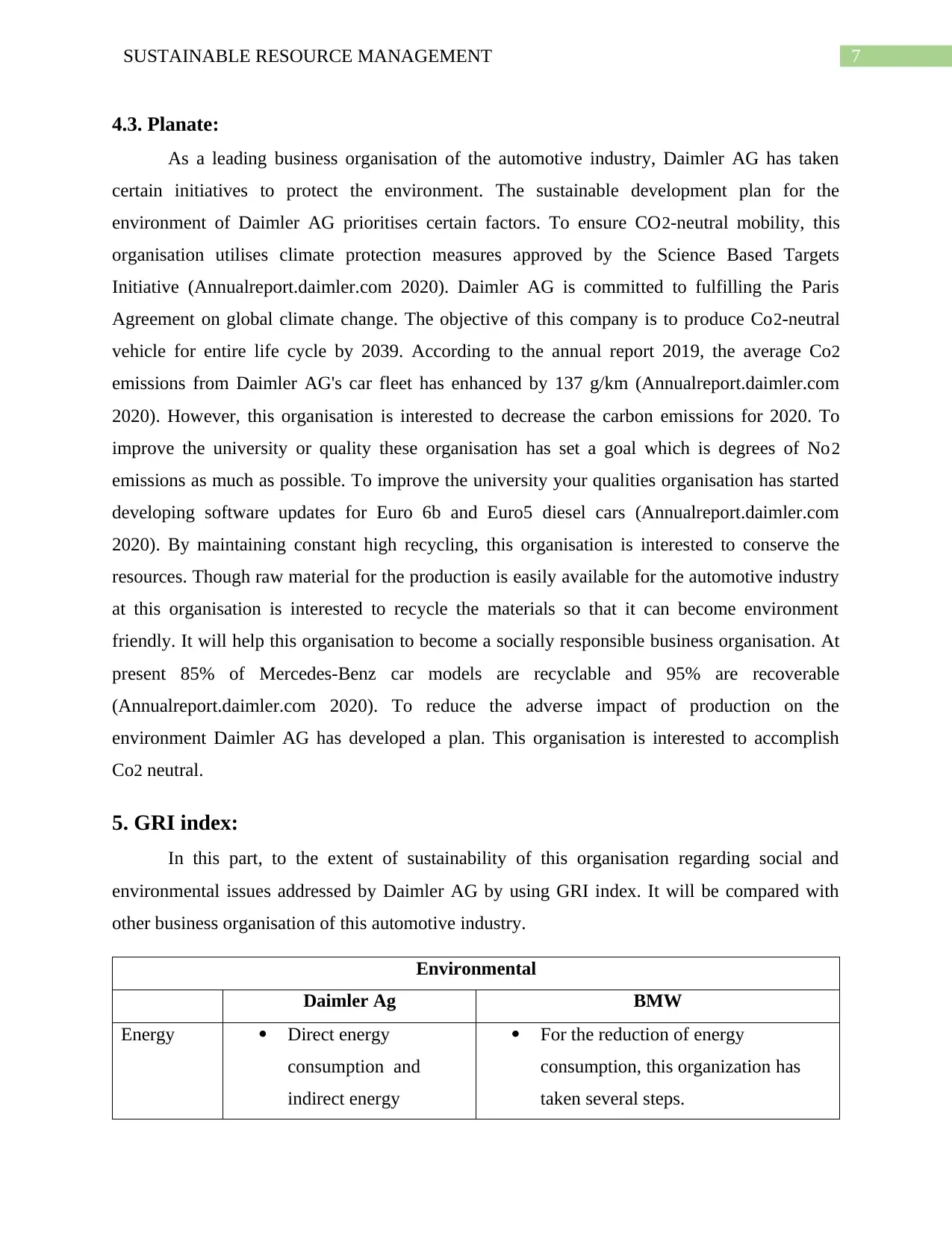
7SUSTAINABLE RESOURCE MANAGEMENT
4.3. Planate:
As a leading business organisation of the automotive industry, Daimler AG has taken
certain initiatives to protect the environment. The sustainable development plan for the
environment of Daimler AG prioritises certain factors. To ensure CO2-neutral mobility, this
organisation utilises climate protection measures approved by the Science Based Targets
Initiative (Annualreport.daimler.com 2020). Daimler AG is committed to fulfilling the Paris
Agreement on global climate change. The objective of this company is to produce Co2-neutral
vehicle for entire life cycle by 2039. According to the annual report 2019, the average Co2
emissions from Daimler AG's car fleet has enhanced by 137 g/km (Annualreport.daimler.com
2020). However, this organisation is interested to decrease the carbon emissions for 2020. To
improve the university or quality these organisation has set a goal which is degrees of No2
emissions as much as possible. To improve the university your qualities organisation has started
developing software updates for Euro 6b and Euro5 diesel cars (Annualreport.daimler.com
2020). By maintaining constant high recycling, this organisation is interested to conserve the
resources. Though raw material for the production is easily available for the automotive industry
at this organisation is interested to recycle the materials so that it can become environment
friendly. It will help this organisation to become a socially responsible business organisation. At
present 85% of Mercedes-Benz car models are recyclable and 95% are recoverable
(Annualreport.daimler.com 2020). To reduce the adverse impact of production on the
environment Daimler AG has developed a plan. This organisation is interested to accomplish
Co2 neutral.
5. GRI index:
In this part, to the extent of sustainability of this organisation regarding social and
environmental issues addressed by Daimler AG by using GRI index. It will be compared with
other business organisation of this automotive industry.
Environmental
Daimler Ag BMW
Energy Direct energy
consumption and
indirect energy
For the reduction of energy
consumption, this organization has
taken several steps.
4.3. Planate:
As a leading business organisation of the automotive industry, Daimler AG has taken
certain initiatives to protect the environment. The sustainable development plan for the
environment of Daimler AG prioritises certain factors. To ensure CO2-neutral mobility, this
organisation utilises climate protection measures approved by the Science Based Targets
Initiative (Annualreport.daimler.com 2020). Daimler AG is committed to fulfilling the Paris
Agreement on global climate change. The objective of this company is to produce Co2-neutral
vehicle for entire life cycle by 2039. According to the annual report 2019, the average Co2
emissions from Daimler AG's car fleet has enhanced by 137 g/km (Annualreport.daimler.com
2020). However, this organisation is interested to decrease the carbon emissions for 2020. To
improve the university or quality these organisation has set a goal which is degrees of No2
emissions as much as possible. To improve the university your qualities organisation has started
developing software updates for Euro 6b and Euro5 diesel cars (Annualreport.daimler.com
2020). By maintaining constant high recycling, this organisation is interested to conserve the
resources. Though raw material for the production is easily available for the automotive industry
at this organisation is interested to recycle the materials so that it can become environment
friendly. It will help this organisation to become a socially responsible business organisation. At
present 85% of Mercedes-Benz car models are recyclable and 95% are recoverable
(Annualreport.daimler.com 2020). To reduce the adverse impact of production on the
environment Daimler AG has developed a plan. This organisation is interested to accomplish
Co2 neutral.
5. GRI index:
In this part, to the extent of sustainability of this organisation regarding social and
environmental issues addressed by Daimler AG by using GRI index. It will be compared with
other business organisation of this automotive industry.
Environmental
Daimler Ag BMW
Energy Direct energy
consumption and
indirect energy
For the reduction of energy
consumption, this organization has
taken several steps.
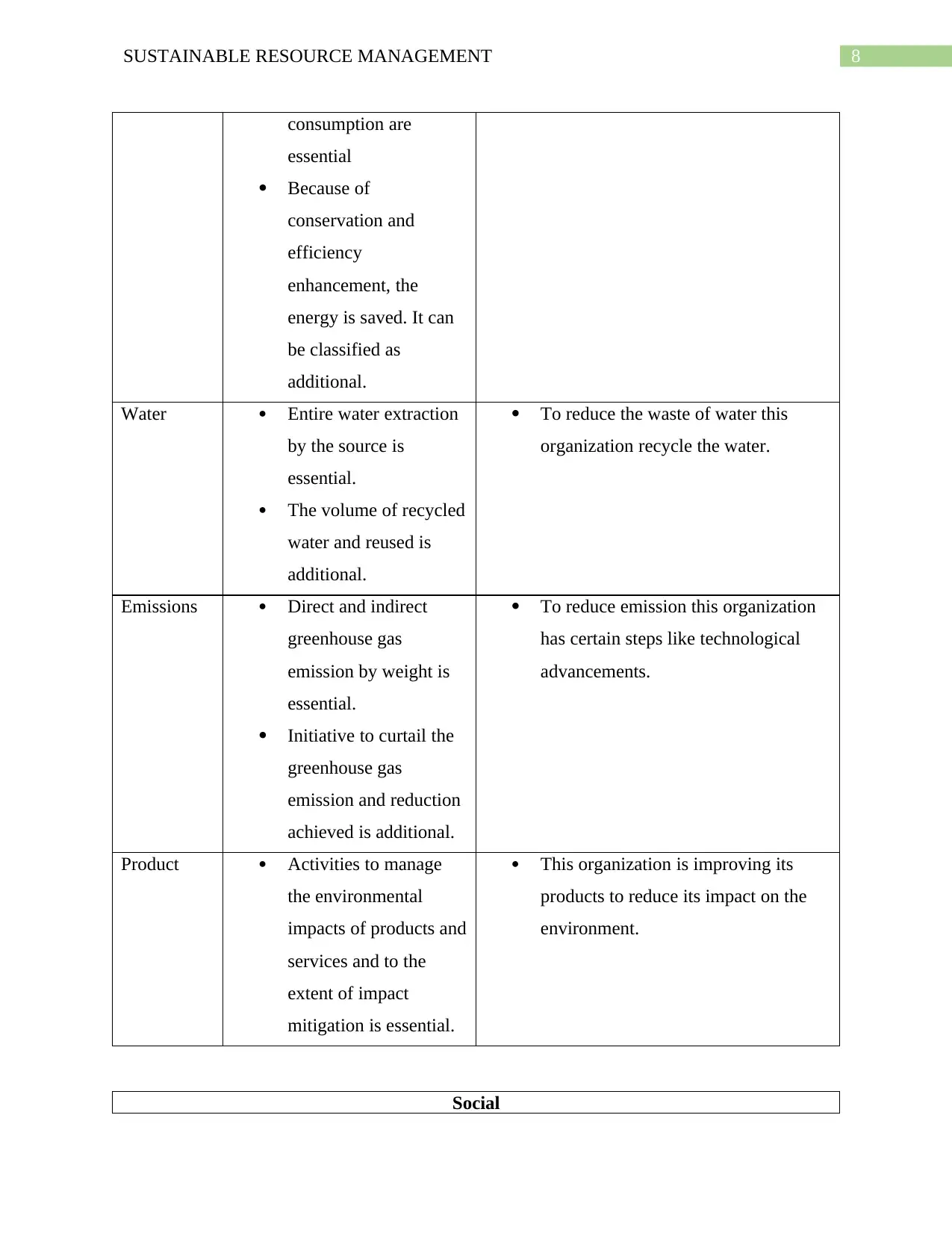
8SUSTAINABLE RESOURCE MANAGEMENT
consumption are
essential
Because of
conservation and
efficiency
enhancement, the
energy is saved. It can
be classified as
additional.
Water Entire water extraction
by the source is
essential.
The volume of recycled
water and reused is
additional.
To reduce the waste of water this
organization recycle the water.
Emissions Direct and indirect
greenhouse gas
emission by weight is
essential.
Initiative to curtail the
greenhouse gas
emission and reduction
achieved is additional.
To reduce emission this organization
has certain steps like technological
advancements.
Product Activities to manage
the environmental
impacts of products and
services and to the
extent of impact
mitigation is essential.
This organization is improving its
products to reduce its impact on the
environment.
Social
consumption are
essential
Because of
conservation and
efficiency
enhancement, the
energy is saved. It can
be classified as
additional.
Water Entire water extraction
by the source is
essential.
The volume of recycled
water and reused is
additional.
To reduce the waste of water this
organization recycle the water.
Emissions Direct and indirect
greenhouse gas
emission by weight is
essential.
Initiative to curtail the
greenhouse gas
emission and reduction
achieved is additional.
To reduce emission this organization
has certain steps like technological
advancements.
Product Activities to manage
the environmental
impacts of products and
services and to the
extent of impact
mitigation is essential.
This organization is improving its
products to reduce its impact on the
environment.
Social
⊘ This is a preview!⊘
Do you want full access?
Subscribe today to unlock all pages.

Trusted by 1+ million students worldwide
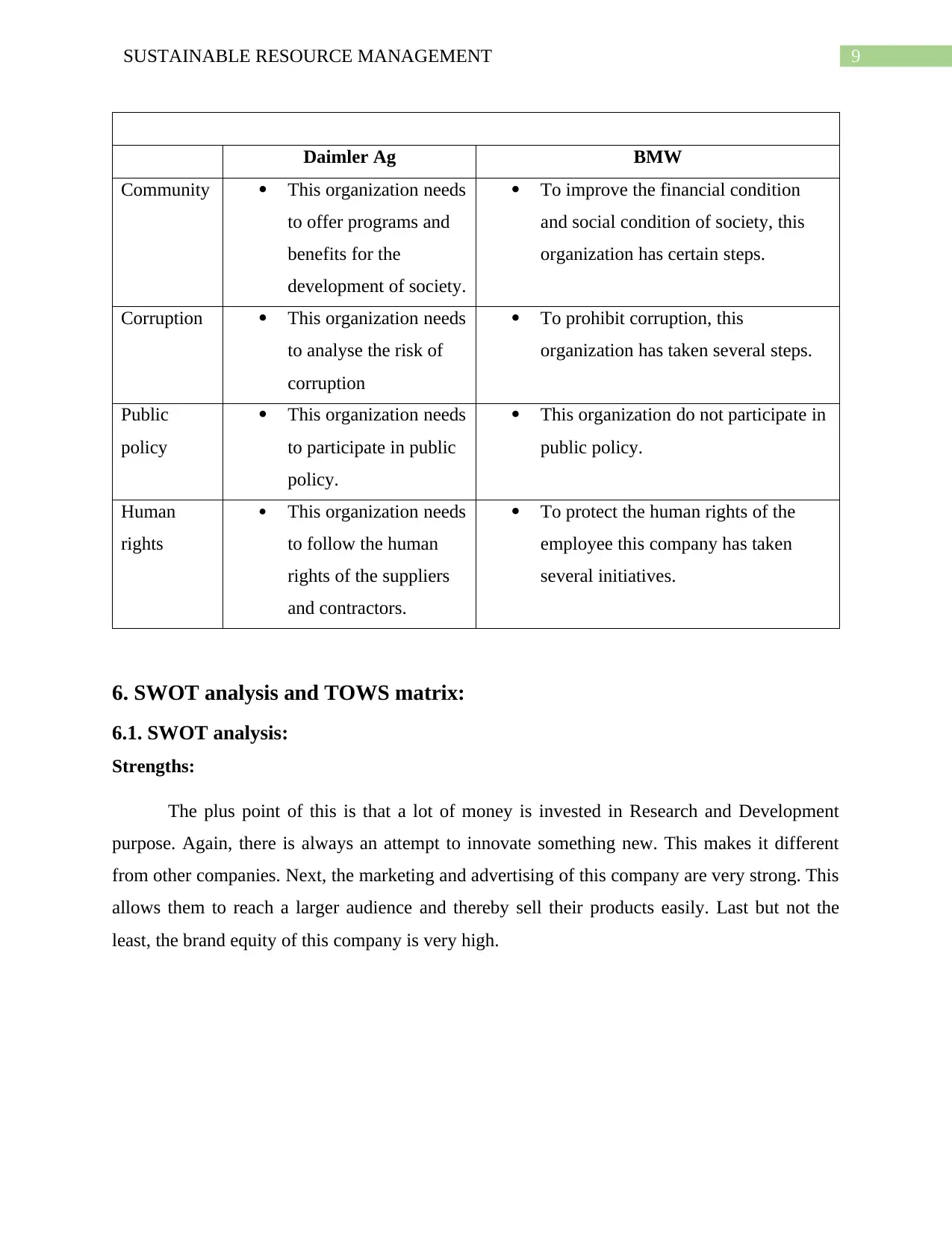
9SUSTAINABLE RESOURCE MANAGEMENT
Daimler Ag BMW
Community This organization needs
to offer programs and
benefits for the
development of society.
To improve the financial condition
and social condition of society, this
organization has certain steps.
Corruption This organization needs
to analyse the risk of
corruption
To prohibit corruption, this
organization has taken several steps.
Public
policy
This organization needs
to participate in public
policy.
This organization do not participate in
public policy.
Human
rights
This organization needs
to follow the human
rights of the suppliers
and contractors.
To protect the human rights of the
employee this company has taken
several initiatives.
6. SWOT analysis and TOWS matrix:
6.1. SWOT analysis:
Strengths:
The plus point of this is that a lot of money is invested in Research and Development
purpose. Again, there is always an attempt to innovate something new. This makes it different
from other companies. Next, the marketing and advertising of this company are very strong. This
allows them to reach a larger audience and thereby sell their products easily. Last but not the
least, the brand equity of this company is very high.
Daimler Ag BMW
Community This organization needs
to offer programs and
benefits for the
development of society.
To improve the financial condition
and social condition of society, this
organization has certain steps.
Corruption This organization needs
to analyse the risk of
corruption
To prohibit corruption, this
organization has taken several steps.
Public
policy
This organization needs
to participate in public
policy.
This organization do not participate in
public policy.
Human
rights
This organization needs
to follow the human
rights of the suppliers
and contractors.
To protect the human rights of the
employee this company has taken
several initiatives.
6. SWOT analysis and TOWS matrix:
6.1. SWOT analysis:
Strengths:
The plus point of this is that a lot of money is invested in Research and Development
purpose. Again, there is always an attempt to innovate something new. This makes it different
from other companies. Next, the marketing and advertising of this company are very strong. This
allows them to reach a larger audience and thereby sell their products easily. Last but not the
least, the brand equity of this company is very high.
Paraphrase This Document
Need a fresh take? Get an instant paraphrase of this document with our AI Paraphraser
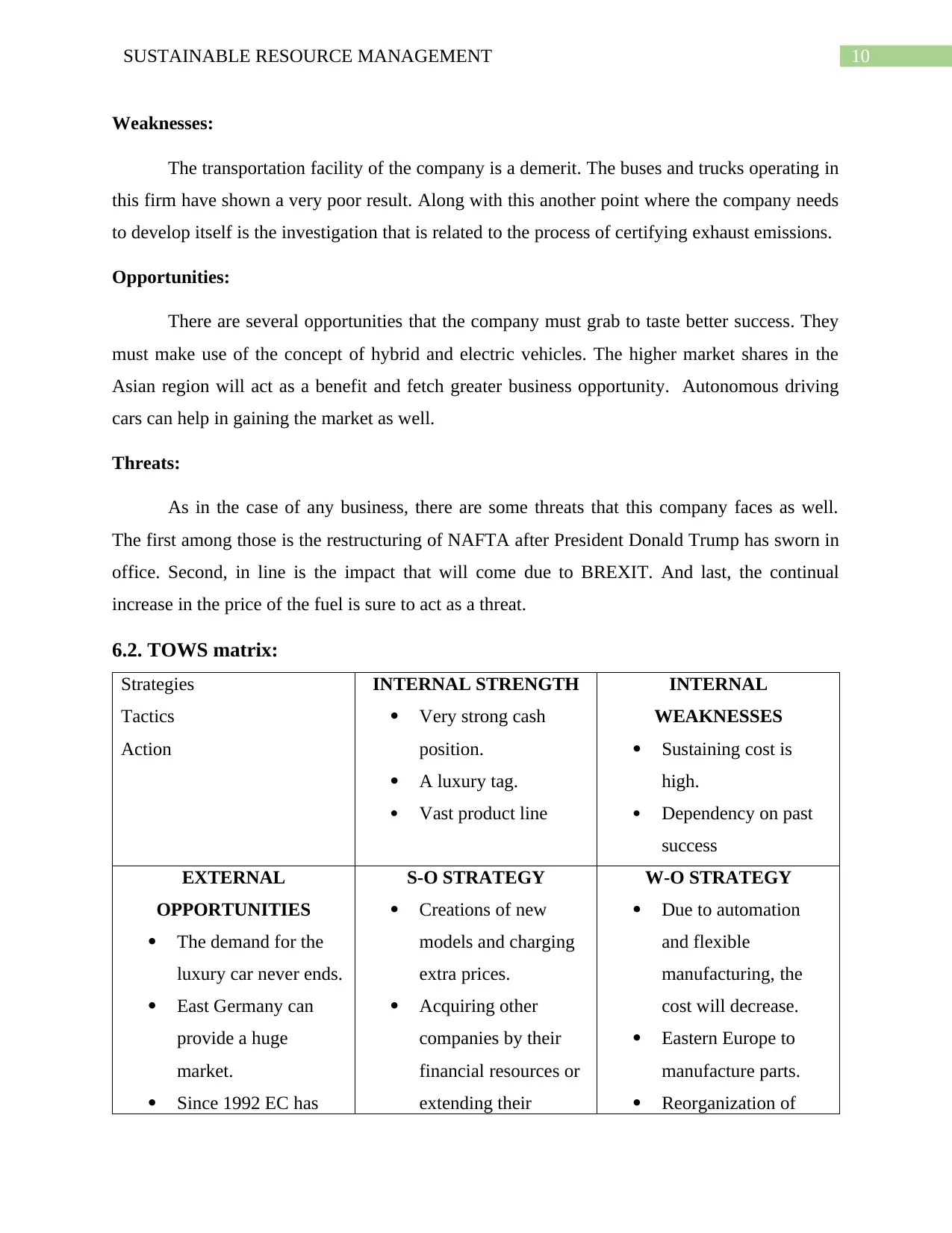
10SUSTAINABLE RESOURCE MANAGEMENT
Weaknesses:
The transportation facility of the company is a demerit. The buses and trucks operating in
this firm have shown a very poor result. Along with this another point where the company needs
to develop itself is the investigation that is related to the process of certifying exhaust emissions.
Opportunities:
There are several opportunities that the company must grab to taste better success. They
must make use of the concept of hybrid and electric vehicles. The higher market shares in the
Asian region will act as a benefit and fetch greater business opportunity. Autonomous driving
cars can help in gaining the market as well.
Threats:
As in the case of any business, there are some threats that this company faces as well.
The first among those is the restructuring of NAFTA after President Donald Trump has sworn in
office. Second, in line is the impact that will come due to BREXIT. And last, the continual
increase in the price of the fuel is sure to act as a threat.
6.2. TOWS matrix:
Strategies
Tactics
Action
INTERNAL STRENGTH
Very strong cash
position.
A luxury tag.
Vast product line
INTERNAL
WEAKNESSES
Sustaining cost is
high.
Dependency on past
success
EXTERNAL
OPPORTUNITIES
The demand for the
luxury car never ends.
East Germany can
provide a huge
market.
Since 1992 EC has
S-O STRATEGY
Creations of new
models and charging
extra prices.
Acquiring other
companies by their
financial resources or
extending their
W-O STRATEGY
Due to automation
and flexible
manufacturing, the
cost will decrease.
Eastern Europe to
manufacture parts.
Reorganization of
Weaknesses:
The transportation facility of the company is a demerit. The buses and trucks operating in
this firm have shown a very poor result. Along with this another point where the company needs
to develop itself is the investigation that is related to the process of certifying exhaust emissions.
Opportunities:
There are several opportunities that the company must grab to taste better success. They
must make use of the concept of hybrid and electric vehicles. The higher market shares in the
Asian region will act as a benefit and fetch greater business opportunity. Autonomous driving
cars can help in gaining the market as well.
Threats:
As in the case of any business, there are some threats that this company faces as well.
The first among those is the restructuring of NAFTA after President Donald Trump has sworn in
office. Second, in line is the impact that will come due to BREXIT. And last, the continual
increase in the price of the fuel is sure to act as a threat.
6.2. TOWS matrix:
Strategies
Tactics
Action
INTERNAL STRENGTH
Very strong cash
position.
A luxury tag.
Vast product line
INTERNAL
WEAKNESSES
Sustaining cost is
high.
Dependency on past
success
EXTERNAL
OPPORTUNITIES
The demand for the
luxury car never ends.
East Germany can
provide a huge
market.
Since 1992 EC has
S-O STRATEGY
Creations of new
models and charging
extra prices.
Acquiring other
companies by their
financial resources or
extending their
W-O STRATEGY
Due to automation
and flexible
manufacturing, the
cost will decrease.
Eastern Europe to
manufacture parts.
Reorganization of
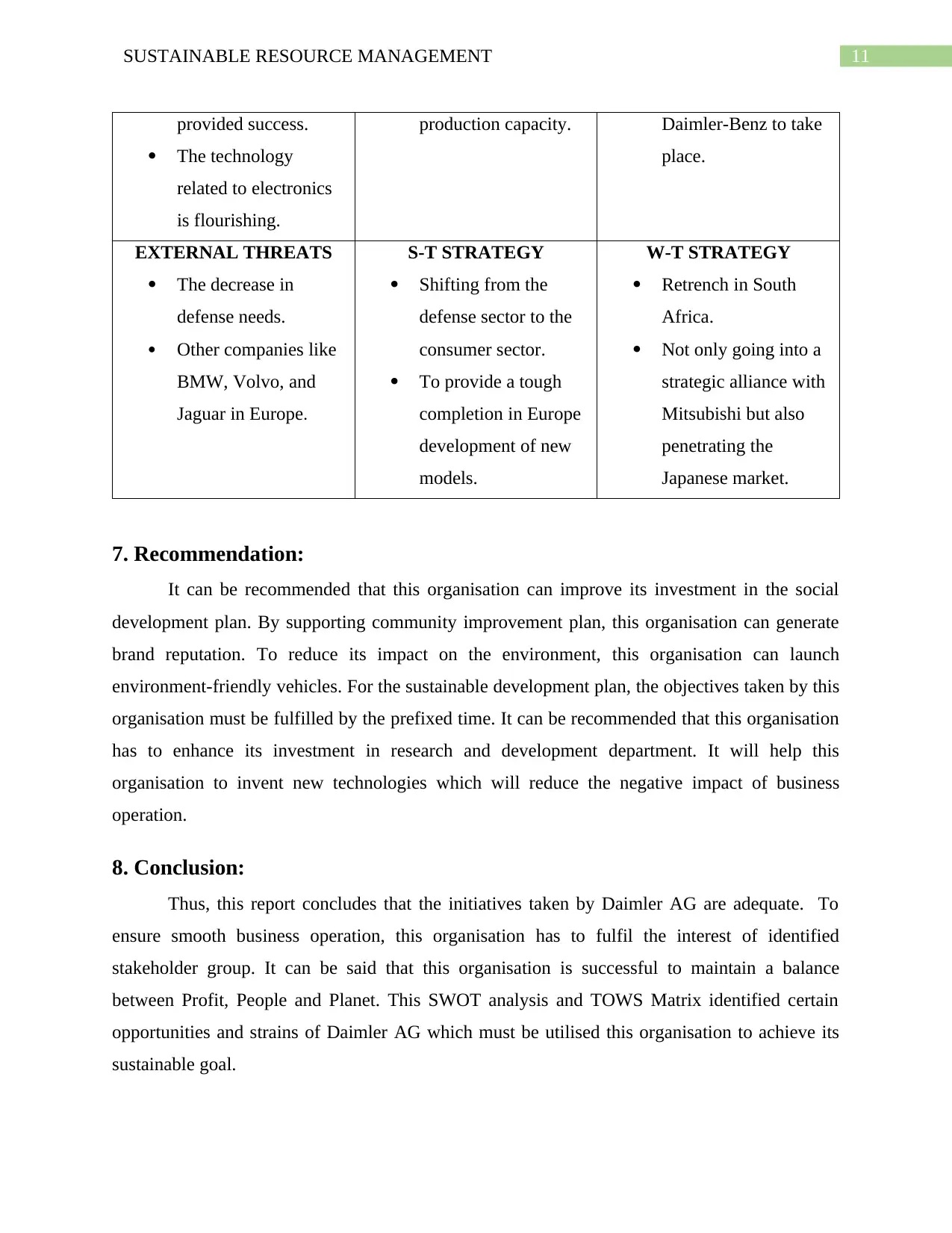
11SUSTAINABLE RESOURCE MANAGEMENT
provided success.
The technology
related to electronics
is flourishing.
production capacity. Daimler-Benz to take
place.
EXTERNAL THREATS
The decrease in
defense needs.
Other companies like
BMW, Volvo, and
Jaguar in Europe.
S-T STRATEGY
Shifting from the
defense sector to the
consumer sector.
To provide a tough
completion in Europe
development of new
models.
W-T STRATEGY
Retrench in South
Africa.
Not only going into a
strategic alliance with
Mitsubishi but also
penetrating the
Japanese market.
7. Recommendation:
It can be recommended that this organisation can improve its investment in the social
development plan. By supporting community improvement plan, this organisation can generate
brand reputation. To reduce its impact on the environment, this organisation can launch
environment-friendly vehicles. For the sustainable development plan, the objectives taken by this
organisation must be fulfilled by the prefixed time. It can be recommended that this organisation
has to enhance its investment in research and development department. It will help this
organisation to invent new technologies which will reduce the negative impact of business
operation.
8. Conclusion:
Thus, this report concludes that the initiatives taken by Daimler AG are adequate. To
ensure smooth business operation, this organisation has to fulfil the interest of identified
stakeholder group. It can be said that this organisation is successful to maintain a balance
between Profit, People and Planet. This SWOT analysis and TOWS Matrix identified certain
opportunities and strains of Daimler AG which must be utilised this organisation to achieve its
sustainable goal.
provided success.
The technology
related to electronics
is flourishing.
production capacity. Daimler-Benz to take
place.
EXTERNAL THREATS
The decrease in
defense needs.
Other companies like
BMW, Volvo, and
Jaguar in Europe.
S-T STRATEGY
Shifting from the
defense sector to the
consumer sector.
To provide a tough
completion in Europe
development of new
models.
W-T STRATEGY
Retrench in South
Africa.
Not only going into a
strategic alliance with
Mitsubishi but also
penetrating the
Japanese market.
7. Recommendation:
It can be recommended that this organisation can improve its investment in the social
development plan. By supporting community improvement plan, this organisation can generate
brand reputation. To reduce its impact on the environment, this organisation can launch
environment-friendly vehicles. For the sustainable development plan, the objectives taken by this
organisation must be fulfilled by the prefixed time. It can be recommended that this organisation
has to enhance its investment in research and development department. It will help this
organisation to invent new technologies which will reduce the negative impact of business
operation.
8. Conclusion:
Thus, this report concludes that the initiatives taken by Daimler AG are adequate. To
ensure smooth business operation, this organisation has to fulfil the interest of identified
stakeholder group. It can be said that this organisation is successful to maintain a balance
between Profit, People and Planet. This SWOT analysis and TOWS Matrix identified certain
opportunities and strains of Daimler AG which must be utilised this organisation to achieve its
sustainable goal.
⊘ This is a preview!⊘
Do you want full access?
Subscribe today to unlock all pages.

Trusted by 1+ million students worldwide
1 out of 14
Related Documents
Your All-in-One AI-Powered Toolkit for Academic Success.
+13062052269
info@desklib.com
Available 24*7 on WhatsApp / Email
![[object Object]](/_next/static/media/star-bottom.7253800d.svg)
Unlock your academic potential
Copyright © 2020–2025 A2Z Services. All Rights Reserved. Developed and managed by ZUCOL.





